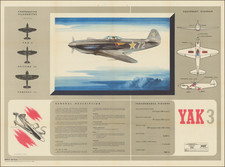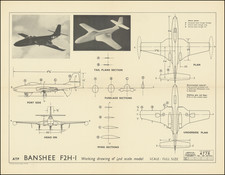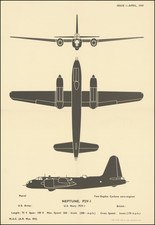FJ-1 FURY, an aircraft identification poster prepared by the Ministry of Supply and promulgated by the Admiralty, War Office, and Air Ministry in December 1950, presents an insightful documentation of the FJ-1 Fury fighter aircraft. The poster, printed by G.C.M. Printing Service Ltd. for H.M. Stationery Office in Leicester, encapsulates the key features and the pioneering advancements of this significant American fighter jet.
In the immediate post-war period, the advancement of jet propulsion technology was ushering a transformative phase in global aviation. The FJ-1 Fury epitomized this era of innovation. Taking its maiden flight on November 27th, 1946, it soon established a landmark achievement by reaching a Mach number of 0.87 in early 1947, the fastest for an American fighter at that time. Furthermore, its historic sea operations in March 1948 aboard the U.S.S Boxer marked the first operational jet landing and take-off at sea, underscoring its pivotal role in aviation history.
Technical innovation is showcased in the aircraft's design and features. Its deep fuselage is noteworthy given the incorporation of the slim axial-flow turbine, specifically the Allison TG-180 (J-35A). One of the pioneering designs introduced in the FJ-1 FURY was the "kneeling" nosewheel leg, which ensured an elevated jet-blast when the aircraft was stationary. This design not only adjusted the jet's position on the ground but also allowed for efficient stowage by fitting the nose of one jet under the rear fuselage of another. Such design nuances reflected the rapid adaptations and innovations aimed at maximizing the efficiency and utility of these jets in varied circumstances.
The FJ-1 Fury was equipped for combat, boasting an armament of six 50 in. machine guns strategically positioned around the nose air intake. This formidable weaponry, combined with a maximum speed surpassing 479 knots and a balanced design—with a length of 33' 8" and a span of 38' 1—marked the Fury as a quintessential representation of mid-century American aviation prowess.













![(Cold War U.S. Aircraft Identification) Thunderjet P-84 [Thunderjet F-84]](https://storage.googleapis.com/raremaps/img/small/96742.jpg)
![[ World Powers - Confrontation or Relaxation? ] Weltmachte-Konfrontation oder Entspannung?](https://storage.googleapis.com/raremaps/img/small/90939.jpg)